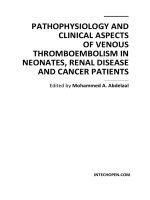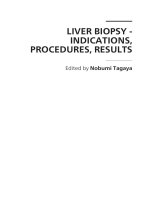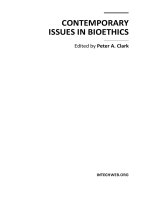Maxillofacial Surgery Edited by Leon A. Assael pptx
Bạn đang xem bản rút gọn của tài liệu. Xem và tải ngay bản đầy đủ của tài liệu tại đây (7.22 MB, 94 trang )
MAXILLOFACIAL SURGERY
Edited by Leon A. Assael
Maxillofacial Surgery
Edited by Leon A. Assael
Published by InTech
Janeza Trdine 9, 51000 Rijeka, Croatia
Copyright © 2012 InTech
All chapters are Open Access distributed under the Creative Commons Attribution 3.0
license, which allows users to download, copy and build upon published articles even for
commercial purposes, as long as the author and publisher are properly credited, which
ensures maximum dissemination and a wider impact of our publications. After this work
has been published by InTech, authors have the right to republish it, in whole or part, in
any publication of which they are the author, and to make other personal use of the
work. Any republication, referencing or personal use of the work must explicitly identify
the original source.
As for readers, this license allows users to download, copy and build upon published
chapters even for commercial purposes, as long as the author and publisher are properly
credited, which ensures maximum dissemination and a wider impact of our publications.
Notice
Statements and opinions expressed in the chapters are these of the individual contributors
and not necessarily those of the editors or publisher. No responsibility is accepted for the
accuracy of information contained in the published chapters. The publisher assumes no
responsibility for any damage or injury to persons or property arising out of the use of any
materials, instructions, methods or ideas contained in the book.
Publishing Process Manager Vedran Greblo
Technical Editor Teodora Smiljanic
Cover Designer InTech Design Team
First published May, 2012
Printed in Croatia
A free online edition of this book is available at www.intechopen.com
Additional hard copies can be obtained from
Maxillofacial Surgery, Edited by Leon A. Assael
p. cm.
ISBN 978-953-51-0627-2
Contents
Preface VII
Chapter 1 Radiologic Evaluation, Principles of Management, Treatment
Modalities and Complications of Orofacial Infections 1
Babatunde O. Akinbami
Chapter 2 Aetio-Pathogenesis and
Clinical Pattern of Orofacial Infections 13
Babatunde O. Akinbami
Chapter 3 The Forearm Flap – Indications, Appropriate Selection,
Complications and Functional Outcome 29
Raphael Ciuman and Philipp Dost
Chapter 4 Mandibular Condylar Hiperplasia 47
Everton Da Rosa, Júlio Evangelista De Souza Júnior and
Melina Spinosa Tiussi
Chapter 5 The Mandibular Nerve:
The Anatomy of Nerve Injury and Entrapment 71
M. Piagkou, T. Demesticha, G. Piagkos,
Chrysanthou Ioannis, P. Skandalakis and E.O. Johnson
Preface
Oral and maxillofacial surgery is a specialty rooted in dentistry and forged in
academic medical centers in departments of surgery, as the surgical specialty well
equipped to care for conditions of the mouth, jaws, head and neck. Today oral and
maxillofacial surgeons are advancing cancer care, neurosciences, understanding the
pathology of the region, managing congenital and acquired deformities among others.
In the process this specialty is improving the lives of our patients with better function,
appearance, self esteem and longevity.
This text is unique in that it is developed online and published in that fashion. It also
addresses some unique issues that are important subsets of the needs of oral and
maxillofacial surgery patients. While it does not comprehensively address the field,
the papers enclosed provide an important niche in the development of the future
specialty of oral and maxillofacial surgery
Dr. Leon A. Assael
Oregon Health and Science University,
USA
1
Radiologic Evaluation, Principles of
Management, Treatment Modalities and
Complications of Orofacial Infections
Babatunde O. Akinbami
Department of Oral and Maxillofacial Surgery,
University of Port Harcourt Teaching Hospital, Rivers State,
Nigeria
1. Introduction
1.1 Radiological evaluation of orofacial infection
Intraoral x-rays
Periapical view is useful to show the affected tooth/teeth crown, root apex in cases of caries,
fracture, impaction and periodontitis
Occlusal view is useful to show any stone in the submandibular salivary gland
which may cause an ascending infection in the gland and later spread to the soft tissue
space
Plain soft tissue x-rays of the skull, jaws and neck are useful to see expansions in the
soft tissue spaces in the head and neck region.
Also plain hard tissue x-rays such as the tangential Posterior-anterior view can show calculi
in the parotid duct
Conventional posterior-anterior, oblique laterals are useful to show mixed osteolytic
changes (radiolucencies) and new bone formation (radioopacities) in chronic osteomyelitis
of the mandible; which is the classical moth eaten appearance.
For the maxilla, occipitomental and true lateral views are useful.
However, a single view of orthopantomogram (panorex) is useful for both mandible and
maxilla
Chest x-rays
Computerized tomographic scan is mainly useful for bone lesions as in osteomyelitis
giving reduced CT no. in areas of bone destruction and close to normal CT no. in areas
of bone formation. Fluids, abscesses and exudates gives varying opacities and lucencies
with CT no. more than that of water (0) and cerebrospinal fluid (7) but less than fat
(100) and bone (1000).
Maxillofacial Surgery
2
1.2 Types of CT scans
1. Traditional or single slice CT scan- produces single slice of images from the data
obtained from detectors in the gantry. The patient’s table must be turned to allow
another 360 degrees revolution for a second slice of 3mm or less to be made.
2. Spiral CT scan- Allows simultaneous movement of table and x-ray tube; has a single row
of detectors which produces volumetric data set and allows reconstruction of multiple
slices of images obtained in a single revolution. The images can also be reformatted and
viewed in multiple planes with the Pictural archival communication system. Also has the
advantage of less artifact due to swallowing because a single breathe hold is utilized,
gives better vascular opacification and small contrast bolus is needed to enhance lesions.
3. Multi-detector CT scan- has a matrix of detectors which sends volumetric data sets to
produce multiple slices of images in more than the three planes at one revolution
thereby increasing the speed of imaging.
4. New Tom CT scan (Schick, NIM, S.r.l., Verona, Italy) produces axial panoramic images
and 3D data set for multiplanar images. It is a cone-beam CT scan which apart from the
3D dimensional imaging produced, also exposes patients to less radiations, but not
useful for inflammatory swellings.
5. Contrast enhanced CT. scan- Contrast is introduced to enhance imaging of soft tissue
space infections.
Magnetic resonance imaging clearly demarcates the exudates accumulation and
expansions within the soft tissue compartments. In the T2 weighted sequence image,
soft tissue space swellings appear more opaque than the soft tissues while the bones
appear dark.
Fig. 1. Shows CT scan demonstrating a retropharygeal abscess; excerpt from
anaerobicinfections.blogspot.com
Radiologic Evaluation, Principles of Management,
Treatment Modalities and Complications of Orofacial Infections
3
Fig. 2. Shows CT scan demonstrating a collection of gas filled abscess in the neck; excerpt
from anaerobicinfections.blogspot.com
Fig. 3. Shows Contrast enhanced CT scan demonstrating a sublingual space abscess
Maxillofacial Surgery
4
Fig. 4. Shows Contrast enhanced CT scan demonstrating left parapharygeal space abscess
excerpt from abcradiology.blogspot.com
Fig. 5. Shows Contrast enhanced CT scan demonstrating a left buccal space abscess
Radiologic Evaluation, Principles of Management,
Treatment Modalities and Complications of Orofacial Infections
5
Fig. 6. Shows Contrast enhanced CT scan demonstrating multiple abscess in Ludwig’s
angina; excerpt from abcradiology.blogspot.com
Maxillofacial Surgery
6
Ultrasound scan is also useful for superficial soft tissue imaging with probes of high
frequencies of 7.5Mhz and above
Scintiscanning is very useful to ascertain the presence of exudates within bone
especially in the early phase as well as in the established phase of acute osteomyelitis,
producing high signals in the spectrum of that of inflammations. X-rays and CT scans
may not be very useful in acute osteomyelitis to demonstrate early bone changes.
Soft tissues and exudates are best evaluated using contrast medium, therefore the best
imaging technique is contrast CT-scan. The soft tissues, spaces and exudates appear
radioopaque on contrast CT scans. Moreover, CT scan is cheaper, readily available and has
no electromagnetic effects on patients with metallic implants compared to MRI and most
patients do not react to the contrast medium (Gadolinium) which is injected into the body
via intravenous route before the scan. Pre-operative and post- operative evaluation of the
lesions/swellings by these imaging modalities not only assist in the diagnosis but also serve
as a guide in the treatment and monitoring of progress. Incision and decompression,
sequestrectomies are now being done under ultrasonic and CT guidance.
2. Principles of treatment and treatment modalities of orofacial infection
Thorough evaluation of the patients with these infections, elimination of local factors and
control of systemic diseases contribute to the successful management and good outcome.
Effective decompression, choice and dosages of antibiotics, compliance of patients are measures
necessary to combat these problems with a view to reducing the morbidity and mortality.
The spread of the infections in patients with periapical periodontitis and dentoalveolar
abscess who present early to the hospital is better curtailed with empirical broad spectrum
oral antibiotics within five days to 1 week.
Capsule amoxycillin 500mg or amoxycillin/clavulanate and
Tablet metronidazole 400mg 8hrly
Analgesic tablet paracetamol or ibuprufen
For infections that have spread to the potential spaces;
It is better to admit;
Commence empirical intravenous antibiotics,
No gold standard for antibiotic regime, based on the polymicrobial etiologic nature of
odontogenic infections, patients can be given
intravenous metronidazole 500mg/100ml 8hrly for 72hrs
with intravenous broad spectrum antibiotic amoxycillin/clavulanate or ceftriaxone
commenced before the outcome of the m/c/s results.
Parenteral Analgesics;
either paracetamol or
selective cyclo-oxygenase enzyme inhibitor, non- steroidal anti-inflammatory drugs;
celecoxib or
non-selective, diclofenac with misoprostol to protect the gastric/duodenal wall.
Radiologic Evaluation, Principles of Management,
Treatment Modalities and Complications of Orofacial Infections
7
Rehydrate with intravenous fluids, Dextrose saline 5% alternate with Normal saline 0.9% 1
liter 8hrly for 72hrs, fluid control however should be depend on degree of dehydration,
renal status, input/output chart. An average output of 1-2mls per minute per kg body
weight must be maintained.
3. Principles of drainage
Drain abscesses both intraorally or extraorally depending on the site.
Drainage may be done under conscious sedation or general anaesthesia depending on the
extent of spread, airway obstruction, patients’ cooperation and availability of facilities and
necessary skills
For cases to be done under G.A, orotracheal or fibreoptic intubation without muscle
relaxants is preferred to prevent further compromise of the airway. Both forms of intubation
can enhance quicker access or visibility into the airway than nasotracheal.
If there is airway obstruction, cricothyrostomy or tracheostomy may be necessary.
3.1 Procedure
1. Make about 1.5 – 2cm skin incision in the most dependent fluctuant site/sites on the
swelling to aid drainage under gravity where possible.
2. Blunt dissection into the swelling, the swelling is entered with the sinus forceps closed and
then opened and moved in different directions to break multiple loci of pus, drainage is
aided with digital pressure, suction and can be guided by radiologic or endoscopic imaging
3. After satisfactory decompression of exudates, sinus forceps should be removed with the
beaks wide open to avoid gripping of any vital tissue.
For submandibular and Ludwig’s abscesses, the first layer is skin followed by the
subcutaneous tissue and platysma muscle within it, then the outer part of the investing
layer of deep cervical fascia before entering into the submandibular space which is
below the inner part of the investing layer. Further dissection through the inner part
and mylo-hyoid muscle which forms the floor of the mouth allows access into the
sublingual space which is below the oral mucosa. Dissections should be along same line
and at least 3cm away from the lower border of the mandible to avoid the salivary
glands. At least 3 interrupted incisions are made for ludwig’s angina.
For submasseteric abscesses, approach can be transoral (intraoral) or via the neck
(extraoral) or both. Extraoral can be retromandibular- this also allow drainage of
intermuscular planes easily without going through masseter muscle but continuous
drainage is not aided by gravity and extra care must be taken to protect the
retromandibular vein, external carotid artery, and facial nerve. The submandibular
offers access below the angle of the mandible avoiding those structures and drainage
under gravity is better but dissection is through the muscle. Intraoral dissection may be
added to facilitate drainage and incision is made on mucosa along the anterior border
of the ramus of mandible, sinus forceps is inserted into the space lateral to the ramus
and medial to masseter
For pterygomandibular space, same intraoral incision at same site allows penetration
into the space, which is medial to the ramus and lateral to the medial pterygoid.
Maxillofacial Surgery
8
For lateral pharyngeal space, same incision, also allow forceps into the space lateral to
the superior constrictor and medial to the medial pterygoid.
For infratemporal space, the incision is extended higher to the coronoid process, the
forceps penetrates medial to the attachment of the temporalis muscle and below the
lateral pterygoid muscle. Care must be taken to avoid the internal maxillary vessels,
mandibular nerve/branches and pterygoid plexus.
For peritonsillar space abscess (Quinsy), incision is made into the mucosa in the
tonsillar bed anterior to the tonsils, quick suctioning of the exudates must be done to
avoid aspirations.
By the second day of admission, when the patient is fairly stable,
Extractions of the causal tooth/teeth should be done and
Commence jaw exercises with mouth gag to continue daily with wooden spatula- this
will improve the mouth opening and aid the drainage of exudate.
By the end of the third day or beginning of fourth day, Empirical antibiotic given needed to
be changed after the arrival of the m/c/s result if response is not satisfactory. Patients with
spreading soft tissue space infections and bone infections have to be admitted for about two
to three weeks.
4. Treatment modalities of osteomyelitis
All cases of suppurative osteomyelitis must be admitted.
Those with acute suppurative osteomyelitis are to commence on fluids and intramuscular
analgesics and empirical antibiotics while waiting for M/C/S result.
Intravenous Sparxfloxacin 200mg 12 hrly for 72hrs with lincomycin 500mg 8hrly or
clindamycin 300mg 12hrly for 4 weeks. If symptoms of necrotizing colitis start, the
macrolides should be stopped.
Those with chronic suppurative osteomyelitis must wait for M/C/S result before given
antibiotic-no need for empirical antibiotics
Also indicated for chronic osteomyelitis is
1. sequestrectomy and
2. excision of the sinus tracts.
4.1 Focal sclerosing osteomyelitis
May not need any intervention but if there is persistent pain or superimposed infection,
Extraction of tooth/teeth
Excision of sclerotic bone, place autograft or allograft bone material if necessary
Antibiotic coverage
4.2 Chronic sclerosing osteomyelitis
There have been controversies over the origin and aetiology of diffuse sclerosing
osteomyelitis. Some authors believe that it is due to organisms like propionibacterium acne and
Radiologic Evaluation, Principles of Management,
Treatment Modalities and Complications of Orofacial Infections
9
peptostreptococcus intermedius found in the deep pockets associated with generalized
periodontitis. Others believe that it may be part of a bone, joint and skin {SAPHO; synovitis,
acne, pustulosis, hyperostosis and osteitis} syndrome probably due to allergic or
autoimmune reaction in the periosteum
7
.
Based on this fact, it has been found that
Corticosteroids or high doses of potent NSAIDs and biphosphonates have been useful
in its management;
With or without prolonged antibiotic therapy and
Decortications as well as thorough
Periodontal tissue management with
Oral hygiene instructions.
4.3 Refractory osteomyelitis
In refractory cases, not responsive to the above treatment, resection of that part of bone
involved and reconstruction with bone grafts with or without alloplastic bone substitutes
and reconstruction plates will be indicated
Occasionally, hyperbaric oxygen daily for 1 month may also be required.
The average period of antibiotic coverage for the patients with soft tissue space infections
and dentoalveolar abscess ranged between 5 to 14days while that for osteomyelitis was
between 4 to 6 weeks. The latest broad spectrum antibiotics now used in the treatment of
orofacial infections are the fourth generation cephalosporins (Cefepime) and the
Imipenems/ cilastin derivatives (Bacqure). Both are exceptional in the treatment of beta
lactamase producing organisms.
5. Complications of orofacial infections
5.1 Early complications
1. Regional and distant spread (abscess in any part of the body)-
Spread of odontogenic infections accounts for up to 57 % of deep neck abscesses (Mihos et
al., 2004). With the potential for infection spreading to the interpleural space and
mediastinal tissue, the mortality rate of mediastinitis continues to be 17–50 % despite
aggressive use of antibiotics and advances in intensive care facilities (Marty-Ane et al.,
1999).
Additional incisions below the swellings have to be made for patients whose infection
had spread to the neck and chest wall, to allow for drainage
For spread into the thorax, a chest tube will be needed at the seventh intercostal space
mid-axillary line or a thoracotomy when there is organisation and consolidation
Paracentesis/laparatomy for abbominal/pelvic abscesses
Orbital decompression will be needed for spreading retrobulbar abscess
Cranial burr holes/craniotomy for intracranial abscess
2. Septicemia and Toxic shock syndrome- recognized by high temperature, pallor,
jaundice, increasing respiratory and pulse rate with reducing blood pressure. Massive
Maxillofacial Surgery
10
and aggressive intravenous antibiotics, intravenous fluids and diet (hyperalimentation),
hyperbaric oxygen and ozone therapy application may be useful but with the risk of
pulmonary toxity.
3. Necrotizing fascitis marked by erythema, blistering and denudation/loss of skin,
subcutaneous tissue, deep fascia and muscle due to devitalization- Excision of
devitalized tissue and repititive debridemole must be done combined with intravenous
antibiotics and antiseptic dressings. High protein diet and fluid intake as well as control
of systemic factors are vital. Biotherapy with honey and larvatherapy are also
applicable.
4. Disseminated intravascular coagulopathy marked by blood coming out from all
orifices in the body; Blood, fresh frozen plasma, cryoprecipitate and factor VIII and
platelet concentrate must be given.
5. Cavernose sinus thrombosis marked by severe headache, vomiting, high temperature,
redness, proptosis and painful swelling of the eyeball/lid and prominent conjunctival
and schlera vessels- Massive and aggressive intravenous antibiotics with anti-
inflammatory analgesics must be given, subcutaneous low dose heparin, intravenous
fluids and diet
6. Chronic suppurative otitis media and mastoditis
7. Stroke (embolic)- Appropriate consult.
8. Death – Death usually occurs due to sepsis and multi-organ failure although airway
occlusion is also a significant complication and requires early management by
tracheostomy. Host factors affected by the patient's general health condition play a
significant role.
5.2 Late complications
1. Ankylosis of the temporomandibular joint
2. Myositis ossificans and
3. Subperiostitis osteomyelitis- the last two is common with improper treated submassetric
abscess
4. Bone destruction and facial deformities
5. Blindness and deafness.
In the study of Akinbami et al., hospitalized patients were rehydrated with intravenous
fluids, 5% dextrose/saline alternate with 0.9% normal saline 1litre 8hrly for 72 hrs. Dextrose
fluid was avoided in patients treated for diabetics. 10 I.U of subcutaneous insulin (humulin)
4hrly was commenced for patients with diabetis mellitus and physicians were consulted to
continue management. The mortality figure was 11.8%. In most studies reviewed, caries was
the most predominant local factor, while diabetic mellitus and malnutrition were
commonest systemic diseases.
6. Conclusion
Control of systemic factors/diseases is a vital and integral component in the management of
these patients with orofacial infections, therefore holistic approach must be adopted to
ensure recovery and reduce mortality.
Radiologic Evaluation, Principles of Management,
Treatment Modalities and Complications of Orofacial Infections
11
7. References
[1] Underhill TE, Laine FJ, George J. Diagnostic imaging of Maxillofacial infections. Oral
Maxillofacial Surg Clin N Am 2003: 15; 39-49.
[2] Jones KC, Silver J, Millar WS, Mandel L. Chronic submasseteric abscess: anatomic,
radiologic and pathologic features: Am J Neuroradiol 2003; 24: 1159-1163.
[3] Furuichi H, Oka M, Takenoshita Y, Kubo K, Shinohara M, Beppu K. A marked
mandibular deviation caused by abscess of the pterygomandibular space. Fukuoka
Igaku Zasshi 1986; 77: 373-377.
[4] Srirompstong S, Srirompotong S. Surgical emphysema following intraoral drainage of
buccal space abscess. J Med Assoc Thai 2002; 85: 1314-1316.
[5] Baqain ZH, Newman L, Hyde N. How serious are oral infections? J Laryngol Otol 2004;
118: 561-565.
[6] Miller EJ Jr, Dodson TB. The risk of serious odontogenic infections in HIV-positive
patients: a pilot study Oral Surg Oral Med Oral Pathol Oral Radiol Endod1998; 86:
406-409.
[7] Ugboko VI, Owotade FJ, Ajike SO, Ndukwe KC, Onipede AO. A study of orofacial
bacterial infections in elderly Nigerians. SADJ 2002; 57: 391-394.
[8] Ndukwe KC, Fatusi OA, Ugboko VI. Craniocervical necrotizing fasciitis in Ile-Ife,
Nigeria. Br J Oral Maxillofac Surg 2002; 40: 64-67.
[9] Hodgson TA, Rachanis CC. Oral fungal and bacterial infections in HIV-infected
individuals: an overview in Africa. Oral Dis 2002; 8 Suppl 2: 80-87.
[10] Fazakerley, M. W., McGowan, P., Hardy, P. & Martin, M. V. (1993). A comparative
study of cephradine, amoxycillin and phenoxymethylpenicillin in the treatment of
acute dentoalveolar infection. Br Dent J 174, 359–363.[CrossRef][Medline]
[11] Flynn, T. R., Shanti, R. M. & Hayes, C. (2006). Severe odontogenic infections, part 2:
prospective outcomes study. J Oral Maxillofac Surg 64, 1104–
1113.[CrossRef][Medline]
[12] Fouad, A. F., Rivera, E. M. & Walton, R. E. (1996). Penicillin as a supplement in
resolving the localized acute apical abscess. Oral Surg Oral Med Oral Pathol Oral
Radiol Endod 81, 590–595.[CrossRef][Medline]
[13] Jimenez, Y., Bagan, J. V., Murillo, J. & Poveda, R. (2004). Odontogenic infections.
Complications. Systemic manifestations. Med Oral Patol Oral Cir Bucal 9 (Suppl.),
143–147.[Medline]
[14] Kuriyama, T., Absi, E. G., Williams, D. W. & Lewis, M. A. (2005). An outcome audit of
the treatment of acute dentoalveolar infection: impact of penicillin resistance. Br
Dent J 198, 759–763.[CrossRef][Medline]
[15] Lewis, M. A., McGowan, D. A. & MacFarlane, T. W. (1986). Short-course high-dosage
amoxycillin in the treatment of acute dento-alveolar abscess. Br Dent J 161, 299–
302.[CrossRef][Medline]
[16] Lewis, M. A., Carmichael, F., MacFarlane, T. W. & Milligan, S. G. (1993). A randomised
trial of co-amoxiclav (Augmentin) versus penicillin V in the treatment of acute
dentoalveolar abscess. Br Dent J 175, 169–174.[CrossRef][Medline]
[17] Mangundjaja, S. & Hardjawinata, K. (1990). Clindamycin versus ampicillin in the
treatment of odontogenic infections. Clin Ther 12, 242–249.[Medline]
Maxillofacial Surgery
12
[18] Marty-Ane, C. H., Berthet, J. P., Alric, P., Pegis, J. D., Rouviere, P. & Mary, H. (1999).
Management of descending necrotizing mediastinitis: an aggressive treatment for
an aggressive disease. Ann Thorac Surg 68, 212–217.[Abstract/Free Full Text]
[19] Mihos, P., Potaris, K., Gakidis, I., Papadakis, D. & Rallis, G. (2004). Management of
descending necrotizing mediastinitis. J Oral Maxillofac Surg 62, 966–
972.[CrossRef][Medline]
[20] Palmer, N. O. A., Martin, M. V., Pealing, R. V. & Ireland, R. S. (2000). An analysis of
antibiotic prescriptions from general dental practice in England. J Antimicrob
Chemother 46, 1033–1035.[Abstract/Free Full Text]
[21] Gill, Y. & Scully, C. (1990). Orofacial odontogenic infections: review of microbiology
and current treatment. Oral Surg Oral Med Oral Pathol 70, 155–
158.[CrossRef][Medline]
[22] Gilmore, W. C., Jacobus, N. V., Gorbach, S. L., Doku, H. C. & Tally, F. P. (1988). A
prospective double-blind evaluation of penicillin versus clindamycin in the
treatment of odontogenic infections. J Oral Maxillofac Surg 46, 1065–1070.[Medline]
[23] Tung-Yiu, W., Jehn-Shyun, H., Ching-Hung, C. & Hung-An, C. (2000). Cervical
necrotizing fasciitis of odontogenic origin: a report of 11 cases. J Oral Maxillofac
Surg 58, 1347–1352.[CrossRef][Medline]
[24] Turner Thomas, T. (1908). Ludwig's angina. An anatomical, clinical, and statistical
study. Ann Surg 47, 161–163.[Medline]
[25] Wang, L. F., Kuo, W. R., Tsai, S. M. & Huang, K. J. (2003). Characterizations of life-
threatening deep cervical space infections: a review of one hundred ninety-six
cases. Am J Otolaryngol 24, 111–117.[CrossRef][Medline]
[26] Wang, J., Ahani, A. & Pogrel, M. A. (2005). A five-year retrospective study of
odontogenic maxillofacial infections in a large urban public hospital. Int J Oral
Maxillofac Surg 34, 646–649.[CrossRef][Medline].
[27] Currie WJR, Ho V. An unexpected death associated with an acute dentoalveolar
abscess- Report of a case. Br J Oral Maxillofac Surg 1993; 31:296-298.
[28] Akinbami BO, Akadiri OA, Gbujie DC. Spread of orofacial infections in Port Harcourt,
Nigeria. J Oral Maxillofac Surg 2010: 68; 2472-2477.
2
Aetio-Pathogenesis and
Clinical Pattern of Orofacial Infections
Babatunde O. Akinbami
Department of Oral and Maxillofacial Surgery,
University of Port Harcourt Teaching Hospital, Rivers State,
Nigeria
1. Introduction
Microbial induced inflammatory disease in the orofacial/head and neck region which
commonly arise from odontogenic tissues, should be handled with every sense of urgency,
otherwise within a short period of time, they will result in acute emergency situations.
1,2
The
outcome of the management of the conditions are greatly affected by the duration of the
disease and extent of spread before presentation in the hospital, severity(virulence of
causative organisms) of these infections as well as the presence and control of local and
systemic diseases.
Odontogenic tissues include
1. Hard tooth tissue
2. Periodontium
2. Predisposing factors of orofacial infections
Local factors and systemic conditions that are associated with orofacial infections are listed
below.
Local factors Systemic factors
1. Caries, impaction, pericoronitis Human immunodeficienc
y
virus
2. Poor oral h
yg
iene, periodontitis Alcoholism
3. Trauma Measles, chronic malaria, tuberculosis
4. Foreign body, calculi
Diabetis mellitus, h
y
po- and
hyperthyroidism
5. Local fun
g
al and viral infections Liver disease, renal failure, heart failure
6. Post extraction/sur
g
er
y
Blood d
y
scrasias
7. Irradiatio
n
Steroid therap
y
8. Failed root canal therap
y
C
y
totoxic dru
g
s
9. Needle in
j
ections Excessive antibiotics,
10. Secondar
y
infection of tumors, c
y
st,
fractures
Malnutrition
11. Allergic reactions
Anaemia, Sickle cell disease
Maxillofacial Surgery
14
In addition, low socio-economic status, level of education, neglect, self medication and
ignorance are contributory factors to the development, progress and outcome of the
infections
2
.
3. The anatomical fascial spaces and spread of soft tissue space infection
Despite the fact that there are fasciae, muscles and bones which not only separate this region
into compartments, but also serve as barriers, infections can still spread beyond the
dentoalveolar tissues.
2-4
In cases due to highly virulent organisms and also when the defense mechanism of the
patient is compromised by systemic diseases, there is usually a fast spread into
neighbouring, distant and intravascular spaces
Presence of teeth and the roots below or above the attachment of the soft tissues to bone
Density and vascularity of bone
Presence of contiguous potential spaces in this region which are interconnected.
Attachment of deep cervical fascia.
The deep cervical fascia has three divisions which separate the head and neck into
compartments; the divisions include the investing (superficial), middle and deep
layers. The investing layer is directly beneath the subcutaneous tissue and
platysma, it is attached to the lower border of the mandible superiorly and the
sternum and clavicle inferiorly.
5
The middle layer encircles central organs which
include the larynx, trachea, pharynx and strap muscles, it also forms the carotid
sheath anteriorly. It extends into the mediastinum to attach to the pericardium.
5
The deep layer is divided into the alar fascia and the prevertebral fascia.
5
The alar
fascia completes the carotid sheath posteriorly and also encloses the
retropharyngeal space which extends from the base of the skull to the level of the
sixth cervical vertebra. The prevertebral fascia bounds the potential prevertebral
space anteriorly. It is attached to the fourth thoraxic vertebra. There is an actual
space between the alar and prevertebral fascia which extends down to the
diaphragm.
The floor of the mouth is separated from the anterior part of the neck by the mylo-
hyoid muscle. Above this muscle is the sublingual space and this link directly with
the opposite side and at the posterior aspect of the mouth it links with the
submandibular space.
5
The investing layer attached to the mandible is folded into
two sheaths, the upper sheath is in close proximity to the mylohyoid muscle above
while the lower sheath is above the platysma, between the two is the
submandibular space. The two sides of the submandibular space are separated by
connective tissue septum. The body of the mandible and maxilla separates the oral
cavity and the vestibule. The buccinator muscle limits the vestibule inferiorly and
separates the buccal space from the vestibule.
Infections commonly start from the teeth or gums and these can spread via the
roots or around the crowns of the teeth. It has been documented that infections
from the roots of the lower anterior teeth usually spread into the sublingual space
because the mylohyoid muscle attachment is below the roots, while that of the
posterior teeth usually spread into the submandibular space.
6-9
Infections from the
Aetio-Pathogenesis and Clinical Pattern of Orofacial Infections
15
roots of the upper anterior teeth spread into the canine fossa, except from the
lateral incisors which pass more into the palatal space intraorally because of the
palatal orientation of the roots,
8-10
while those from the posterior teeth spread into
the buccal space.
10
Infections from the body of the mandible pass more through the relatively thinner
lingual plate into the medial spaces while that from the body of the maxilla pass
more via the relative thinner buccal plate into the lateral spaces. In addition, the
ramus of the mandible serves as attachment on the outer side for masseter muscle
which separates the submasseteric and supramasseteric spaces and on the inner
aspect, there is attachment of medial pterygoid muscle which seperates the
pterygomandibular and lateral pharyngeal spaces.
5
Infections from the gums around the crowns of the posterior teeth of the mandible
and maxilla commonly spread to the submasseteric or pterygomandibular spaces,
while that from the roots spread into the submandibular or buccal spaces and from
the buccal spaces directly into the sub/supramasseteric spaces.
6-10
Also there can be
spread from the submandibular space posteriorly into pterygomandibular, lateral
pharyngeal and retropharyngeal spaces in the upward and downward direction.
9
Infections can track upwards into the infratemporal fossa between the attachments
of the lateral pterygoid and temporalis muscle and into the supratemporal fossa
leading to scalp abscesses. Infections can also spread into the paranasal sinuses
and further into the skull, meninges, cavernose sinus/other sinuses and brain via
the pterygoid plexus. Infections have also been found to spread downwards via the
neck into the chest wall, mediastinum, pericardial and pleural spaces, pre and post
vertebral spaces, retroperitoneal and pelvic cavities.
5-10
The most alarming spread of these infections is into the blood resulting in the
devastating effects of septicemia which has significantly contributed to high
mortality figures.
11,12
4. Pathogenesis and spread of orofacial bone infections
Rarely does infection from the teeth, periodontium and periapical region spread beyond
dentoalveolar tissue because of the vascularity and density of the basal bones. However,
spread of exudates and microbes into the harversian system of bone (cancellous) below the
inferior alveolar canal and beyond the maxillary sinus can occur when vascularity of the
bone is reduced by excess density and cortication with aging and diseases such as
osteopetrosis.
Lacunae space connections between the alveolar bone and basal bone below the inferior
alveolar canal as well as connections with trabeculae bone around the maxillary sinuses,
enhance spread into the whole mandible or maxilla especially in immunocompromised
patients.
Increased pressure within the bone compromises vascularity causing ischeamia, necrosis of
both trabeculae and lamella bone, and sequestra formation. Exudates escape through the
Volkmann’s canal into the subperiosteal space, stripping the periosteum. Inflammatory
periosteal reaction causes laying down and formation of new bone (involucrum) around the
sequestrum.
Maxillofacial Surgery
16
In the sclerotic, subperiosteatis ossificans types, chronic inflammation due to low grade
infections (less virulent organisms) induces more granulation tissue formation, organisation
of fibrous tissue, consolidation and later dystrophic calcification.
5. Classification of orofacial soft tissue space infections
Infections can be classified based not only on the type of organisms, it can also be
Based on the site/space involved
Spaces related to the mandible include
Submandibular,
Sublingual and
Submental spaces
Sub- , intra- and supramasseteric,
Pterygomandibular,
Lateral pharyngeal and
Infratemporal spaces
2
.
Bilateral submandibular, sublingual and submental spaces are involved in Ludwig’s
angina. The incidence of Ludwig’s angina has declined over the years with the advent
of antibiotics
1
and only 5 cases were recorded in the study of Akinbami 2010.
Fig. 1.
Fig. 2.
Fig. 1 and 2 show Pre-operative and Post-operative Photographs of a 31-year-old patient
treated for Ludwig’s angina, submasseteric absess and buccal space abscess
Aetio-Pathogenesis and Clinical Pattern of Orofacial Infections
17
Spaces related to the maxilla
Soft tissue space infections related to the maxilla and middle third of the face include
Canine fossa abscess, and
Buccal space infections
Infection can be localized in a single space and can also spread to involve multiple
spaces.
Based on the pattern/direction
Below or above the floor of the mouth
Below or above the palate
Based on the extent of spread
Dentoalveolar tissues e.g. periapical, periodontium, alveolar bone, in rare cases to the
basal bone (osteomyelitis)
Soft tissue space around the jaws
Space beyond the jaws e.g. neck, orbit, brain/skull,
Distant sites; chest/pleura space, heart-endocardium, myocardium and pericardium,
diaphragm, vertebra , abdomen and pelvis.
6. Classification of orofacial bone infections
Infections affecting the hard tissues can either be in the form of acute or chronic
dentoalveolar abscess and osteomyelitis.
Osteomyelitis is a more severe bone infection and it can be classified into suppurative or
sclerosing;
Acute suppurative osteomyelitis
Chronic suppurative osteomyelitis,
Focal sclerosing osteomyelitis (Garre’s osteomyelitis)
Diffuse sclerosing osteomyelitis.
It can also be classified based on the site as
Intramedullary osteomyelitis,
Cortical osteomyelitis
Acute and
Chronic periostitis
Subperiostitis ossificans also described by Garre’s
Refractory osteomyelitis
7. Microbial etiology of orofacial infections
The aetiologies of bone, soft tissue and tissue space infections are:
Non-specific bacteria and specific organisms such as viral, fungi, tuberculosis, syphilis and
salmonella species
9
.









